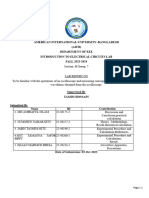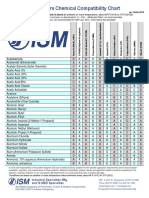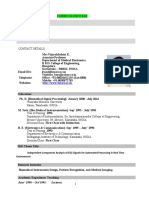AC Circuit Analysis Lab 2
Uploaded by
Uxama MughalAC Circuit Analysis Lab 2
Uploaded by
Uxama MughalAC Circuit Analysis Lab Lab 2
MEASUREMENT OF V PP, VP AND RMS VALUE OF A SINUSOIDAL VOLTAGE WITH
OSCILLOSCOPE
OBJECTIVES
To become more familiar with the oscilloscope.
To learn how to use the various controls on the oscilloscope.
To identify the characteristics of Sinusoidal waveforms.
To understand the difference between RMS and AVERAGE value of the current or
voltage waveform
To observe various waveforms on the oscilloscope and to measure amplitude and
frequency of the waveforms.
LABORATORY EQUIPMENT
DIGITAL MULTI METER
OSCILLOSCOPE
FUNCTION GENERATOR
BREADBOARD
BACKGROUND & THEORY
What is a Signal?
There are different measurable quantities in the world surrounding us. Some quantities are constant
like acceleration due to gravity, speed of light, velocity of sound in air. Some are time-varying like
AC voltage, Pressure, Temperature. It means they change their value as time passes on. Signal simply
means the value of any quantity taken over a period of time. Signals are usually time varying in
nature. Generally a graph is plotted between values at different time instants. This is called graphical
representation of signal.
What is Sine Wave or Sinusoidal Wave Signal?
Sine Wave or Sinusoidal Wave Signal is a special type of signal. It is given by the function
Department of Electrical Engineering Technology, PTUT, Lahore Page 1
AC Circuit Analysis Lab Lab 2
When Sine wave starts from zero and covers positive values, reaches zero; and again covers negative
values, reaches zero, it is said to have completed one cycle or single cycle.
The upper part of sine wave is called positive cycle and the lower part is called negative cycle in a
single cycle. For different values of time, the Signal gives the values of quantity at that time.
Therefore Signal is a function of time. It is therefore written as f(t). The Maximum value of the
Sinusoidal Signal is also called its amplitude (A). Here ω is called Angular Frequency of Signal
AC WAVEFORM CHARACTERISTICS
The Period, (T) is the length of time in seconds that the waveform takes to repeat itself from
start to finish. This can also be called the Periodic Time of the waveform for sine waves, or the
Pulse Width for square waves.
The Frequency, (ƒ) is the number of times the waveform repeats itself within a one second
time period. Frequency is the reciprocal of the time period, (ƒ = 1/T) with the unit of frequency
being the Hertz, (Hz).
The Amplitude (A) is the magnitude or intensity of the signal waveform measured in volts or
amps.
Characteristics of a Sine Wave
Peak-to-Peak Values
The peak-to-peak value of a sine wave is the voltage or current from the positive peak to the negative
peak. The peak-to-peak values are represented as:
Vpp and Ipp
Where:
Vpp = 2Vp and Ipp = 2Ip
Instantaneous Values
The instantaneous values of a sine wave voltage (or current) are different at different points along the
curve, having negative and positive values. Instantaneous values are represented as: V and I.
Department of Electrical Engineering Technology, PTUT, Lahore Page 2
AC Circuit Analysis Lab Lab 2
Peak Value
The peak value of a sine wave is the value of voltage or current at the positive or negative maximum
with respect to zero. Peak values are represented as VP and Ip.
RMS Value
The rms (root mean square) value of a sinusoidal voltage is equal to the dc voltage that produces the
same amount of heat in a resistance as does the sinusoidal voltage.
Vrms = 0.707Vp
Irms = 0.707Ip
Average Value
The average value is the total area under the half-cycle curve Divided by the distance in radians of the
curve along the horizontal axis.
Vavg = 0.637Vp
Iavg = 0.637Ip
Department of Electrical Engineering Technology, PTUT, Lahore Page 3
AC Circuit Analysis Lab Lab 2
PROCEDURE:
1. Connect the output terminals of the function generator to a resistance.
2. Set 1k Ohm resistance as the load on the output of the function generator.
3. Turn on the function generator and use the oscilloscope to observe the voltage drop across
the 1k Ohm resistance. Remember that the oscilloscope’s ground is the same as the
function generator’s ground.
4. Select the sine wave output option of the function generator.
a. Set the frequency of the function generator to 100Hz.
b. Observe the waveform on the oscilloscope using a channel.
c. Adjust the DC offset control of the function generator to obtain a zero DC
level in the output.
d. Use the Function Generator’s output level control (Amplitude control
knob/numerical input) to obtain a 2 Volt peak value (4.0 Vp-p ) on the scope
measurement.
5. Adjust Time /Div. knob to get sufficient time period displacement of the wave on the
Oscilloscope screen.
6. With fine tuning of time/Div. make the waveform steady on screen.
7. Use triggering controls if waveform is not stable.
8. Keep volt/div knob such that waveform is visible on the screen without clipping.
9. Measure P-P reading along y-axis. This reading multiplied with volt/div gives peak to peak
amplitude of the ac input wave.
10. Measure horizontal division of one complete cycle. This division multiplied by time/div
gives time period of the input wave.
11. Calculate frequency using formula f = 1/T.
12. Repeat the steps from 4a to 4d using a triangular wave output from the function generator.
13. Repeat the steps from 4a to 4d using a square wave output from the function generator.
14. Note down your readings in the observation table.
Peak Vertical Amplitude Horizontal
Volt/div Time/div Time Freq.
Function Voltage/ Division (p-p) Division
(b) (d) T = c*d f = 1/T
Frequency (a) V=a*b (c)
2V/100Hz
Sine Wave 4V/100Hz
6V/100Hz
2V/1000Hz
Square 4V/1000Hz
Wave
6V/1000Hz
Department of Electrical Engineering Technology, PTUT, Lahore Page 4
AC Circuit Analysis Lab Lab 2
2V/10kHz
Triangular
4V/10kHz
Wave
6V/10kHz
Learning Outcomes Assessment Questions:
What is the difference between RMS and Average value?
Generate sinusoid wave on hardware with changing offset values.
Which signals have same RMS and peak value?
Which signal has same RMS and average value?
Verify the voltage divider rule for resistive circuit?
Department of Electrical Engineering Technology, PTUT, Lahore Page 5
AC Circuit Analysis Lab Lab 2
Department of Electrical Engineering Technology, PTUT, Lahore Page 6
You might also like
- Operation & Installation Manual For Wave Pool100% (3)Operation & Installation Manual For Wave Pool98 pages
- AC Peak, RMS, and Phase Measurement: AimsNo ratings yetAC Peak, RMS, and Phase Measurement: Aims4 pages
- AC Sinusoidal Analysis: Course Number and NameNo ratings yetAC Sinusoidal Analysis: Course Number and Name7 pages
- AC Electrical Circuit Analysis: Unit - 1No ratings yetAC Electrical Circuit Analysis: Unit - 122 pages
- LecBa_EE11003_ET_AC circuits_intro_phasor_16-23.01.25No ratings yetLecBa_EE11003_ET_AC circuits_intro_phasor_16-23.01.2528 pages
- Experiment 3:-: Measurement of Average and Rms Value of Different Signal Waveforms100% (1)Experiment 3:-: Measurement of Average and Rms Value of Different Signal Waveforms6 pages
- Experiment 3:-: Measurement of Average and Rms Value of Different Signal WaveformsNo ratings yetExperiment 3:-: Measurement of Average and Rms Value of Different Signal Waveforms6 pages
- Elements of Electrical Engineering (01ee0101) : B.Tech. SEM-1No ratings yetElements of Electrical Engineering (01ee0101) : B.Tech. SEM-15 pages
- Chapter 3 Steady State Single Phase AC Circuit Analysis Part 1No ratings yetChapter 3 Steady State Single Phase AC Circuit Analysis Part 124 pages
- Module3 - AC Circuit Analysis - As of 18-Nov-23No ratings yetModule3 - AC Circuit Analysis - As of 18-Nov-2322 pages
- KR10802 Fundamentals of Electrical Engineering: Chapter 6: RLCNo ratings yetKR10802 Fundamentals of Electrical Engineering: Chapter 6: RLC69 pages
- To Be Familiar With An Oscilloscope and AC Waves As Well As Measuring Maximum Value, RMS Value, Time Period and Frequency by Oscilloscope.No ratings yetTo Be Familiar With An Oscilloscope and AC Waves As Well As Measuring Maximum Value, RMS Value, Time Period and Frequency by Oscilloscope.4 pages
- BAB 1 - ALTERNATING VOLTAGE AND CURRENTeditCQI-1No ratings yetBAB 1 - ALTERNATING VOLTAGE AND CURRENTeditCQI-141 pages
- Ch-2&3; particle and fiber board ppt (2)No ratings yetCh-2&3; particle and fiber board ppt (2)19 pages
- tc1972en-ed05_limits_and_dimensioning_for_omnipcx_office_rce_release_10.3No ratings yettc1972en-ed05_limits_and_dimensioning_for_omnipcx_office_rce_release_10.316 pages
- Pulmonary Function Test Results AMC Visit Date 25/02/2023 Prengki Prengki 21/02/1985 Oriental 38 Male 175 71 23,18No ratings yetPulmonary Function Test Results AMC Visit Date 25/02/2023 Prengki Prengki 21/02/1985 Oriental 38 Male 175 71 23,181 page
- Mental Models: An Interdisciplinary Synthesis of Theory and MethodsNo ratings yetMental Models: An Interdisciplinary Synthesis of Theory and Methods13 pages
- Weibull Analysis Guide & Case Study - Pardus ConsultingNo ratings yetWeibull Analysis Guide & Case Study - Pardus Consulting16 pages
- Java Spring Boot Microservices Example - Step by Step Guide - GeNo ratings yetJava Spring Boot Microservices Example - Step by Step Guide - Ge13 pages
- LecBa_EE11003_ET_AC circuits_intro_phasor_16-23.01.25LecBa_EE11003_ET_AC circuits_intro_phasor_16-23.01.25
- Experiment 3:-: Measurement of Average and Rms Value of Different Signal WaveformsExperiment 3:-: Measurement of Average and Rms Value of Different Signal Waveforms
- Experiment 3:-: Measurement of Average and Rms Value of Different Signal WaveformsExperiment 3:-: Measurement of Average and Rms Value of Different Signal Waveforms
- Elements of Electrical Engineering (01ee0101) : B.Tech. SEM-1Elements of Electrical Engineering (01ee0101) : B.Tech. SEM-1
- Chapter 3 Steady State Single Phase AC Circuit Analysis Part 1Chapter 3 Steady State Single Phase AC Circuit Analysis Part 1
- KR10802 Fundamentals of Electrical Engineering: Chapter 6: RLCKR10802 Fundamentals of Electrical Engineering: Chapter 6: RLC
- To Be Familiar With An Oscilloscope and AC Waves As Well As Measuring Maximum Value, RMS Value, Time Period and Frequency by Oscilloscope.To Be Familiar With An Oscilloscope and AC Waves As Well As Measuring Maximum Value, RMS Value, Time Period and Frequency by Oscilloscope.
- tc1972en-ed05_limits_and_dimensioning_for_omnipcx_office_rce_release_10.3tc1972en-ed05_limits_and_dimensioning_for_omnipcx_office_rce_release_10.3
- Pulmonary Function Test Results AMC Visit Date 25/02/2023 Prengki Prengki 21/02/1985 Oriental 38 Male 175 71 23,18Pulmonary Function Test Results AMC Visit Date 25/02/2023 Prengki Prengki 21/02/1985 Oriental 38 Male 175 71 23,18
- Mental Models: An Interdisciplinary Synthesis of Theory and MethodsMental Models: An Interdisciplinary Synthesis of Theory and Methods
- Weibull Analysis Guide & Case Study - Pardus ConsultingWeibull Analysis Guide & Case Study - Pardus Consulting
- Java Spring Boot Microservices Example - Step by Step Guide - GeJava Spring Boot Microservices Example - Step by Step Guide - Ge

























































































